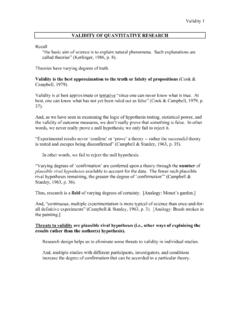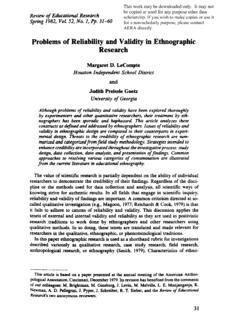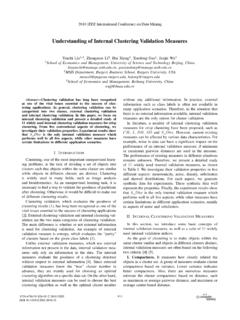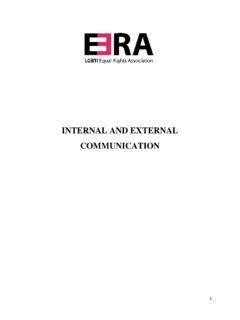Transcription of External Factors, Internal Factors and Self-Directed ...
1 37 Journal of Education and e-Learning Research Vol. 5, No. 1, 37-42, 2018 ISSN(E) 2410-9991 / ISSN(P) 2518-0169 DOI: External Factors , Internal Factors and Self-Directed Learning Readiness Nurjannah Ramli1 Pudji Muljono2 Farit M. Afendi3 ( Corresponding Author) 1 School of Business, Bogor Agricultural University, Indonesia 2 Faculty of Human Ecology, Bogor Agricultural University, Indonesia 3 Faculty of Mathematics and Natural Sciences, Bogor Agricultural University, Indonesia Abstract There are many Factors which affect the level of Self-Directed learning readiness.
2 This study aims to investigate the relationship between External Factors , Internal Factors and Self-Directed learning readiness. This study was carried out by using a census method for fourth year students of medical program of Tadulako University. Data were analyzed quantitatively using analysis tool of Structural Equation Modeling (SEM) with Partial Least Square (PLS) approach. Latent variables in this study consist of Internal Factors , External Factors and Self-Directed learning readiness. The results of this study showed that as much as 24% of the variation in Internal Factors and of the variation in Self-Directed learning readiness is could be explained by variations in the model.
3 The External Factors affected significantly on Internal Factors and Self-Directed learning readiness. The External Factors have a direct positive affect to Internal Factors , while the External Factors have indirect effect on Self-Directed learning readiness through Internal Factors mediation variable. Keywords: External factor, Internal factor, Self-Directed learning readiness. Citation | Nurjannah Ramli; Pudji Muljono; Farit M. Afendi (2018). External Factors , Internal Factors and Self-Directed Learning Readiness. Journal of Education and e-Learning Research, 5(1): 37-42. History: Received: 27 December 2017 Revised: 22 January 2018 Accepted: 26 January 2018 Published: 30 January 2018 Licensed: This work is licensed under a Creative Commons Attribution License Publisher: Asian Online Journal Publishing Group Contribution/Acknowledgement: All authors contributed to the conception and design of the study.
4 This study contributes in the existing literature about Self-Directed learning readiness. The primary contribution of this study is finding that the Internal Factors is e mediator for the effect of External Factors to the Self-Directed learning readiness Funding: This study received no specific financial support. Competing Interests: The authors declare that they have no conflict of interests. Transparency: The authors confirm that the manuscript is an honest, accurate, and transparent account of the study was reported; that no vital features of the study have been omitted; and that any discrepancies from the study as planned have been explained.
5 Ethical: This study follows all ethical practices during writing. Contents 1. Introduction .. 38 2. Methodology .. 38 3. Results and Discussion .. 39 4. Conclusion and Suggestion .. 41 References .. 41 Journal of Education and e-Learning Research, 2018, 5(1): 37-42 38 1. Introduction Problem-based learning is one of the methods that can be applied in student centered learning. Problem-based learning method is a method of learning which demands the liveliness and independence of student in their study. One of the aims of implementing problem based learning is to build and develop students learning in the field of psychomotor in terms of scientific reasoning, critical appraisal, information literacy, Self-Directed learning and life-long learning.
6 Self-Directed learning is an important skill that students need to possess (Conradie, 2014) and capable of helping adults to feel safer during their learning period (Knowles et al., 2005). Self-Directed learning is not only needed in the education world but also needed in the world of work, even the ability of Self-Directed learning has become a prerequisite to live in a rapid dynamic world with rapid changes (Levett-Jones, 2005). Anyone can turn into Self-Directed learner; however, the level of their Self-Directed learning ability depends on many Factors such as motivation for learning, self-confidence, conscience, experience, and intelligence (Cazan and Schiopca, 2014) which are collectively called readiness for Self-Directed learning.
7 Wiley (1983) defined the Self-Directed learning readiness as the degree the individual possesses the attitudes, abilities and personality characteristics necessary for Self-Directed learning . Medical study program is the most in demand major for prospective students. Medical graduates are medical degree holder, if they do not enroll their education to professional level, they will find difficulties during seeking jobs. A candidate for medical degree holder must be prepared to be able to attend clinical education in professional program and physician competence exam to get doctor degree and able to implement life-long learning.
8 Therefore, the students must have sufficient competencies that they obtained from the degree program of medicine; and one of them is Self-Directed learning readiness. Since its establishment, Medical Program of Tadulako University (UNTAD) has applied the problem based learning method, however many obstacles were still perceived by students related to Self-Directed learning including the fourth year students. The obstacles namely lack of initiative and difficulties in managing their study time. Other problems were lack of students awareness and misconceptions about Self-Directed learning.
9 Therefore, it is important to acknowledge the Factors affecting the Self-Directed learning readiness especially among the 4th year students before they continue their education in the professional physician program. The implementation of problem based learning method which demands the students' activeness and independence in learning required an excellent awareness of Self-Directed learning readiness and the Factors affecting the level of Self-Directed learning readiness. The Factors that can affect the Self-Directed learning readiness are Internal Factors and External Factors .
10 The Internal Factors consist of physical health, leisure time availability, hobby or passion, self-maturity, and intelligence. The External Factors consist of family and friends support, faculty facilities, problems encountered, peer relationships, and the influence of parents and friends (Nyambe et al., 2016). The level of students Self-Directed learning readiness also can be influenced by family social support (Tarmidi, 2010) academic environment in terms of learning facilities and academic atmosphere (Leatemia et al., 2016). The goal of this study was to investigate the relationship between External Factors , Internal Factors and Self-Directed learning readiness.
















